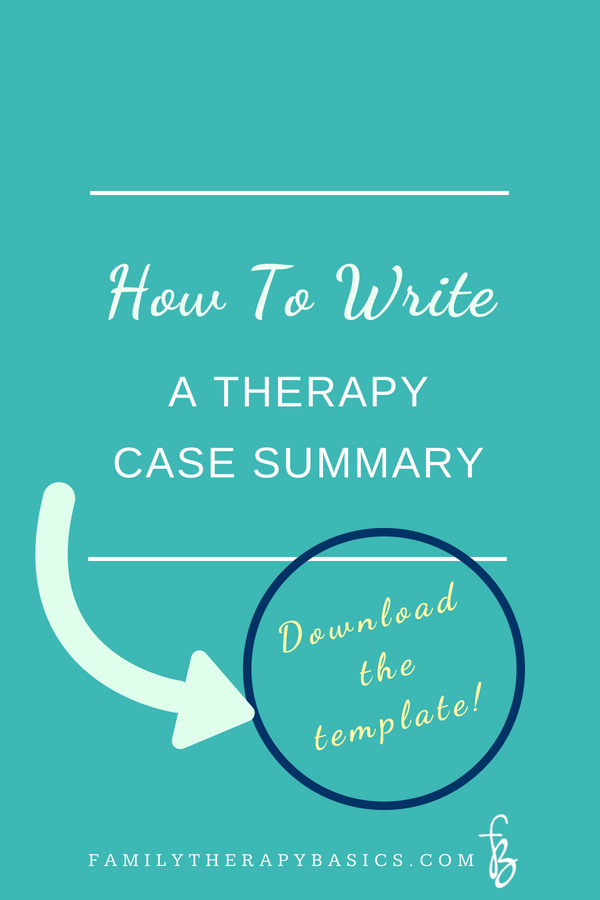Conceptualizing a case systemically can be challenging, because of the many family members and influences that are relevant to our work with clients. In the practicum courses I teach, students are required to write a case summary and present the case to the class. In this post, I outline and explain the sections of the case summary assignment.
You may need to write a case report as part of a class, your job’s paperwork requirements, for billing purposes, to comply with professional providers, or other reasons. The information in this post will serve as a simple template for organizing your case information and ensuring that all relevant details are present in your summary.
1 | Therapy Case History
In this section, summarize essential details related to the history of the case, both before you were the therapist (if relevant) as well as during your work with the client(s).
Some questions to guide you:
How long have the clients been in therapy with you, or at your agency?
What was the initial presenting problem? (State in diagnostic, behavioral, and relational terms).
For example: Sarah presented to therapy with a diagnosis of Major Depressive Disorder (MDD), provided during an initial psychiatric evaluation. She complained of difficulty sleeping, lethargy, and periods of crying, without a clear cause. These symptoms have been present for two years, since she and her husband began having marital conflict due to disagreements about their adult daughter. Their daughter is living in their home and doesn't have a job; this is affecting the couple's financial stability. According to Sarah, she advocates for her daughter, while her husband wants to kick their daughter out of the house.
How has the presenting problem changed over time?
For example:Currently, Sarah is taking medication for symptoms of MDD. She and her husband are in concurrent couples therapy and have negotiated setting boundaries with their daughter. This has relieved the tension between them. Sarah’s presenting problem continues to be her immediate family conflict; however, she has also explained that her family of origin history is relevant to her symptoms of depression. She has begun exploring family of origin patterns of depression and parentification.
What is the history of treatment?
How long has the client been:
in therapy?
on medication?
seeing a psychiatrist?
2 | Systemic Client Assessment
How did you assess information for the case?
Was there a formal assessment process involving a bio/psycho/social, or was assessment more informal?
Were any releases of information necessary for a thorough assessment?
For example: Assessment information was gathered informally, over the course of three sessions. Therapist secured releases of information for Sarah's psychiatrist and primary care physician, and also completed a basic genogram covering three generations of Sarah's family.
What is the client's current context?
Describe the clients' relevant demographic information and socio-cultural contexts, including home, work, significant relationships, and socio-economic status, among others.
What is the client's relational/systemic reality, including significant relationships as well as relational difficulties?
Describe significant relationships, relational conflicts, cut-offs, closeness, and relational patterns. A genogram will help you assess and document this information, which can be included as an appendix in your case summary.
Upon completion of your assessment, what did you decide was pertinent to treatment, and why?
This section serves as a transition from assessment to treatment conceptualization. What were the treatment priorities for the client? How were they determined?
In the next section, treatment priorities are transformed into treatment goals. For example, a treatment priority for the client of, "I want to feel motivated to live my life,"can be expressed as "Sarah will explore times when she feels motivate, and is able to accomplish her desired activities. These experiences will be used as resources for alleviating Sarah's symptoms long-term."
3 | Treatment Focus and Progress
Therapy Goals
What are the goals for treatment?
How did you and the client(s) arrive at choosing these goals? For example, were they chosen:
by a third party who is mandating treatment?
collaboratively, between you and the client(s)?
How did you prioritize the goals?
What progress have the clients made toward their goals? Describe progress using the client's language and perspective.
For example: Sarah has made the following progress toward her main goal, "feeling motivated to live her life:"
Together, therapist and Sarah identified times when Sarah is motivated. She explained that she is most motivated when she is at work. Having concrete, actionable tasks helps Sarah feel useful.
Sarah chose to create daily tasks for herself at home, in order to improve her motivation. She is completing at least 3 tasks daily. She reports feeling proud and more hopeful at this stage of therapy (from a 3 in hope to a 5).
Therapy Interventions
Answer the same questions as above, for interventions.
Some tips for writing this section:
Write it from your perspective.
Remember, interventions need not be formal, complex activities.
Ensure that each intervention and rationale is written with consistent theoretical language.
What have been the treatment interventions?
For example: Therapist used exception questions to find times when Sarah felt motivated.
Explain your clinical rationale for choosing your interventions.
For example: Sarah appeared defeated by her symptoms of lethargy and sadness. However, she was able to describe, in detail, how her work brings her satisfaction. Therapist used this connection to help Sarah transfer her motivation skills from work to home.
What have been the results of each intervention?
For example: Sarah has noticed that depression does not control every area of her life. She decided to begin listing the aspects of her work that bring her a sense of usefulness. She says that seeing areas where she is already motivated has given her a "sense of self-worth and hope."
4 | Client Strengths and Supports
What are the client(s) resources and supports (work, school, family, friends, hobbies, faith, etc.)?
How are they utilized as supports/resources by the client?
What is your sense of the client's resilience resources?
How have they improved, if at all, through therapy?
5 | Evaluation
This section is not often included in traditional case summaries/reports. If evaluation is included, it most often refers to formal evaluations, such as treatment plans and mental health assessments.
In this section, I am interested in how the therapist evaluates the clients' experience in therapy, as well as the client's perspective on his/her own progress and the therapist's effectiveness.
For this section, consider:
How are you evaluating treatment?
Do clients complete an evaluation at the end of treatment?
Do you discuss progress in every session?
How do you assess the clients' sense of satisfaction with your services, and how often?
How do you document evaluation information?
Disclaimer: This outline is meant to serve as a basic template you can tailor to suit your needs.
Grab the 3-page Case Summary Template,
in the free resource library, by registering below:
Let's Chat
What benefit do you see in being intentional about the evaluation process described above?













